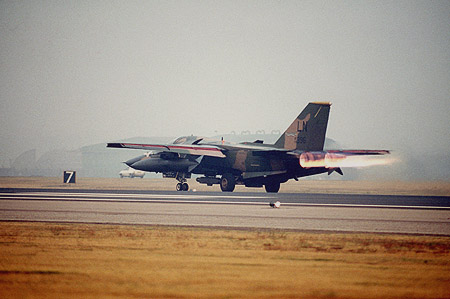|
Global Aircraft -- F-111 Aardvark
Aviation Center
US Attack
US Bombers
US Cargo
US Fighters
US Helicopters
US Patrol/Pursuit
US Reconnaissance
US Tankers
US Trainers
US UAV's
US X Planes
Orbiter Vehicles
WWI Aircraft
WWII Aircraft
Airbus
Antonov
Boeing
Dassault
Ilyushin
Kamov
MiG
Mil
Saab
Sukhoi
Tupolev
Yakovlev
Joint/Rest of World
Entertainment Center
Members Center
New Technologies
Contact Us
Extra Navigation
GAC Engine
F-111 Aardvark Specifications
F-111 Aardvark Achievements
F-111 Aardvark Features
The F-111 has variable-sweep wings that allow the pilot to fly from slow approach speeds to supersonic velocity at sea level and more than twice the speed of sound at higher altitudes. Wings angle from 16 degrees (full forward) to 72.5 degrees (full aft). The F-111 needs no drag chute or reverse thrust to slow down after landing. The two crew members sit side-by-side in a pressurized cockpit module that serves as an emergency escape vehicle and as a survival shelter on land or water. The aircraft's wings and much of the fuselage behind the crew module contain fuel tanks. Using internal fuel only, the plane has a range of more than 2,500 nautical miles. External fuel tanks can be carried on the pylons under the wings and jettisoned if necessary. Source: http://www.au.af.mil
F-111 Aardvark Background
The F-111 is a multipurpose tactical fighter bomber capable of supersonic speeds. It can operate from tree-top level to altitudes above 60,000 feet. The F-111 can carry conventional as well as nuclear weapons . It can carry up to two bombs or additional fuel in the internal weapons bay. External ordnance includes combinations of bombs, missiles and fuel tanks. The loads nearest the fuselage on each side pivot as the wings sweep back, keeping ordnance parallel to the fuselage. Outer pylons do not move but can be jettisoned for high-speed flight. The F-111A first flew in December 1964. The first operational aircraft was delivered in October. A models were used for tactical bombing in Southeast Asia. Developed for the U.S. Navy, the F-111B was canceled before its production. F-111C's are flown by the Royal Australian Air Force. The F-111D has improved avionics with better navigation, air-to-air weapon delivery systems, and newer turbofan engines. The E model has modified air intakes to improve the engine's performance at speeds above Mach 2.2. The F-111F has Improved turbofan engines give F-111F models 35 percent more thrust than previous F-111A and E engines. The avionics systems of the F model combine features of the F-111D and E. The last F-model was delivered to the Air Force in November 1976. The F models have been modified to carry the Pave Tack system in their weapons bays. This system provides an improved capability to acquire, track and designate ground targets at night for delivery of laser, infrared and electro-optically guided weapons. Source: http://www.au.af.mil
| ||||||||||||||||||||||||||||||||||||||





